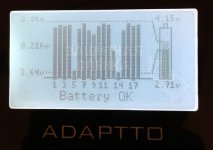Ohbse
10 kW
I did get some results, I'll have to locate my graph data.
Short answer - 30q is superior in power, energy and longevity and all for less money, no brainer.
30q temperature was lower for same load, sag less and delivered ~100 mah more under higher discharge rates. I tested right up to 30a with a temperature cutoff at 75c, they work damn well.
They're superior in pulsed power output even to my 25R and HE4 test cells, ~140watt per cell for 10 seconds.
I've just finishing up with my first couple of battery builds using them - one is 13s6p for a ~400watt ebike, next is a 20s12p replacement battery for my DH Comp street bike which is currently running about 7.5kw peak. I'm just about to start the assembly of pack 3 which is probably going to be 28s15p for my Madass conversion.
From my experience to date I would say the Samsung datasheets are far more conservative than the LG specs. Despite 'only' being rated at 15a vs the 20a of the HG2 I know I'd be taking the Samsung for high discharge use every time based on my testing.
Short answer - 30q is superior in power, energy and longevity and all for less money, no brainer.
30q temperature was lower for same load, sag less and delivered ~100 mah more under higher discharge rates. I tested right up to 30a with a temperature cutoff at 75c, they work damn well.
They're superior in pulsed power output even to my 25R and HE4 test cells, ~140watt per cell for 10 seconds.
I've just finishing up with my first couple of battery builds using them - one is 13s6p for a ~400watt ebike, next is a 20s12p replacement battery for my DH Comp street bike which is currently running about 7.5kw peak. I'm just about to start the assembly of pack 3 which is probably going to be 28s15p for my Madass conversion.
From my experience to date I would say the Samsung datasheets are far more conservative than the LG specs. Despite 'only' being rated at 15a vs the 20a of the HG2 I know I'd be taking the Samsung for high discharge use every time based on my testing.


